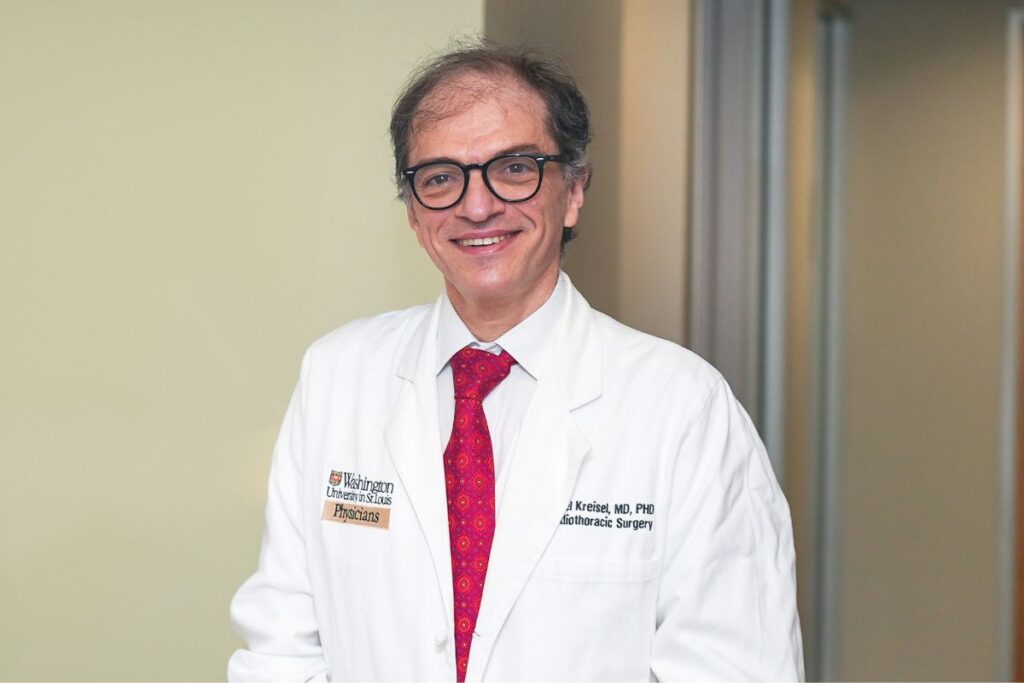Surgical Director of the Washington University Lung Transplant Program Daniel Kreisel, MD, PhD, and a team of Washington University researchers recently collaborated with Harvard University School of Medicine investigators to look into how the body adjusts to lung transplantation.
The study, entitled “Resolvin D1 prevents injurious neutrophil swarming in transplanted lungs,” co-authored by Kreisel and Charles Serhan, PhD, DSc, Director of the Center for Experimental Therapeutics and Reperfusion Injury at Brigham and Women’s Hospital and a pioneer in the field of inflammation resolution, was published in The Proceedings of the National Academy of Science (PNAS). Wenjun Li, MD, Associate Professor of Surgery at Washington University and Hailey Shepherd, MD, a surgery resident at Washington University shared first authorship.
Ischemia-reperfusion injury (IRI) is a common and potentially dangerous complication following lung transplantation. During transplant, the donated lung is cut off from the blood supply. When circulation returns to the donated lung in the recipient’s body, immune responses in both the recipient and donor organ can lead to injury. IRI causes tissue damage in the transplanted organ, which can sometimes lead to graft failure and can be deadly for the patient in severe cases.
Due to the commonality and high-risk of IRI, investigations into the exact causes and methods of prevention for the condition have been gaining traction in recent research. This often includes studies of the immune system and how it interacts with a transplanted organ in the recipient. Immune system responses often contribute to complications for lung transplant patients, including the activation of neutrophils – powerful white blood cells which can swarm and attack the transplanted lung – and inflammatory responses – which play a large role in conditions such as IRI. Despite what recent research has uncovered about immune response and IRI, questions still remain about what can be done to prevent or treat this potentially deadly condition.
The study delves into a novel idea which could provide foundations for effective therapies to tackle IRI by focusing on the body’s natural immune response. Through the use of methods including metabololipidomics (the study of lipid’s role in biological processes), intravital two-photon imaging (a method of imaging live cell tissue) and single-cell RNA sequencing, Kreisel’s and Serhan’s laboratories investigated the way specialized proresolving mediators (SPMs) in the body function when a new lung is introduced into a patient in both human and mouse models. SPMs are substances known to naturally combat inflammation and help return the body to a stable state known as homeostasis. The study looked into one such SPM – a lipid mediator known as Resolvin D1 or RvD1 – to examine how it may be effective in combating or preventing the dangerous immune responses and inflammation that characterize IRI.
When a transplant patient’s body receives a new organ, the immune system of the patient and that of the transplanted organ engage in a “complicated cross talk,” Kreisel explains. One way to help mitigate the potential harmful results of this cross talk is known as immunosuppression, wherein the body’s immune system is intentionally weakened. This can prevent the body from attacking the new organ, but with a weakened immune system, the patient’s body is then less able to fight off bacteria and other harmful invaders that can cause further harm.
The current study of RvD1 heralded promising results: RvD1 prevents neutrophil swarming in transplanted lungs, fights excess inflammation and exhibits other protective and healing effects which combat the same symptoms seen in cases of IRI. This breakthrough has massive potential in the field of preventing or treating IRI and other immune-related conditions seen in transplant patients. By understanding how the body naturally combats the negative effects of immune responses on grafted organs, new pathways for therapies harnessing and utilizing these effective biological processes can be explored. By uncovering how RvD1 reduces early tissue damage in the delicate stages after lung transplantation, further research can explore how to enhance RvD1 and other SPMs to promote healing and prevent harm following transplant to diminish, treat or even prevent conditions such as IRI.
